Keywords Search
Entries List Search
Microbiota Information in MDIPID
Drug Information in MDIPID
Disease Information in MDIPID
Protein Information in MDIPID
Search Methods Available in MDIPID
Data Content Available in MDIPID
General Information of Microbial Taxa
Interaction Atlas of This Microbial Taxa
Effect of This Microbial Taxa on Drug
Drug (or Substance) Influence of This Microbial Taxa
Variation in the Abundance of This Microbial Taxa Across Phenotypes
General Information of Drug
Interaction Atlas of This Drug
Effect of This Drug on the Microbiota
Microbiota Influence of This Drug
General Information of Disease Phenotype
Interaction Atlas of This Disease Phenotype
Molecular Expression Atlas of DTP
List of Drug(s) That Treat This Disease As An Indication
Variation in the Abundance of Microbiota Across This Disease Phenotype
General Information of Microbial Protein
Interaction Atlas of This Microbial Protein
Effect of This Microbial Protein on Drugs
The most frequently used keyword searches are set up at the top of the "Home" page of MDIPID and each search page. In the keyword search, users can search for the entries they wanted using any keyword related to the entries they were searching for. Users can switch between search pages by clicking the "Microbiota", "Drug", "Disease", and "Protein" buttons at the top of the homepage.

In the keyword search, users can search for the entries they wanted using any keyword related to the entries they were searching for.

Taking a microbiota as an example, users can search and find the information they want about microbiota by inputting keywords about microbiota species name, microbiota genus name, drug name, disease name, microbial protein name and any other keywords related to the microbiota.
Query can be submitted by entering keywords into the main searching frame. Users can specify part or full name in the text field. To facilitate a more customized input query, the wildcard characters of "*" and "?" are also supported in MDIPID. For example:
If search "Serratia" and click the "Search" button, find five entries with name "Serratia sp. AS12 ", "Serratia proteamaculans"," Serratia sp.","Serratia marcescens" and "Serratia odorifera ". If you only want the result of " Serratia marcescens", double quotation marks are required when you search the Microbiota name;
If search: "?junii", finds entries with Microbiota names, like "Acinetobacter junii" represents any one character;
If search: "Anti-CTLA* ", finds entries with Anti-CTLA-4 related Microbiota names, like "Blautia obeum". Here "*" represents a string of any length. In this case, it represents "4".
In addition to the usual keyword searches, MDIPID also offers Entries List-based searches for Entries including Microbiota, Drug, Disease, and Protein. The main difference between this List-based search and the keyword search is that the List-based search matches the content text in an exact rather than a fuzzy way, in other words, only content that is identical to the entry selected by the user will be retrieved.

In each of the different drop-down search boxes, MDIPID provides information about different Entries, for example, in the case of microbiota, the website has set up 3 drop-down menus "Microbiota Genus & Species Name", "Drug Status & Name", and "Disease Class & Name", and users can select the item they are interested in to search for microbiotas related to this item.
On the search page for microbiota, MDIPID offers a keyword search field for microbiotas and 3 drop down menu search fields that included "Microbiota Genus & Species Name", "Drug Status & Name", and "Disease Class & Name", the user can select the item they are interested in to search for microbiotas related to this item.

The search results page for a microbiota briefly displays information about Microbiota Species Name, Microbiota Type, Microbiota Genus, and Representative Microbial Protein, specifically, users can obtain further General Information of Microbial Protein by clicking on the highlighted protein in the "Representative Protein" section.
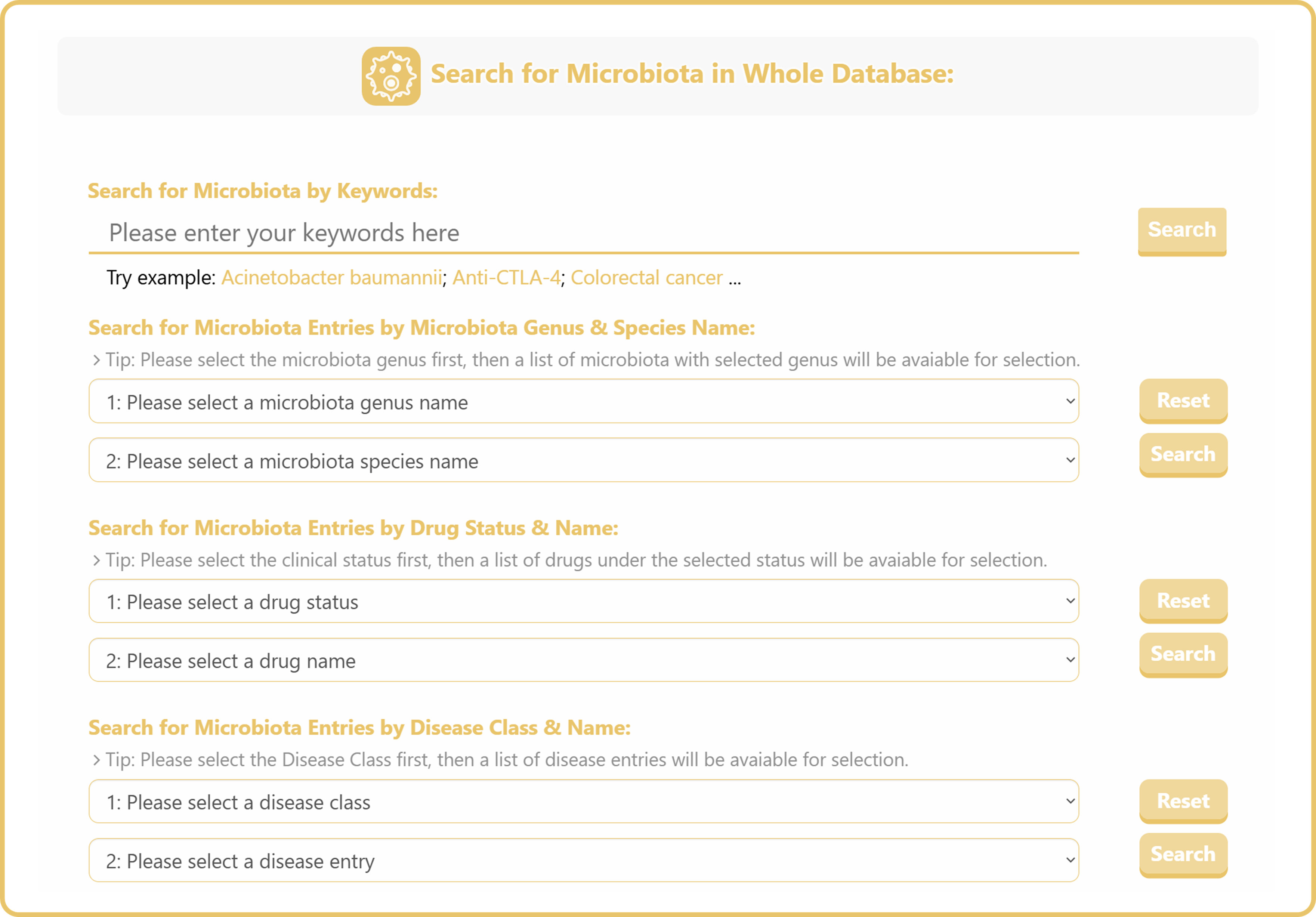
General Information of Microbial Taxa
In the "General Information of Microbial Taxa" section of the microbial taxa Information page, MDIPID provides information on the Species Name, Taxonomy ID, Lineage (detailed classification from kingdom to species). Specifically, users can click on the arrow in the "lineage" section to be redirected to the corresponding information in the Taxonomy Database.

Interaction Atlas of This Microbial Taxa
In the "Interaction Atlas of This Microbial Taxa" section of the microbial taxa information page, MDIPID provides basic information about drugs and disease that interacting with the microbial taxa in form of interaction map and tables.
In the interaction atlas, specific microbial taxa is placed right in the central and all drugs and diseases that directly interact with this microbial taxa are distributed around the microbial taxa and are directly connected to it (the direction of interaction is indicated by arrows). In addition, the proteins related to the microbial taxa's impact on drugs will be connected to the corresponding drugs. This atlas is interactive, and users can hover over each bubble to view the detailed information in the bubble.
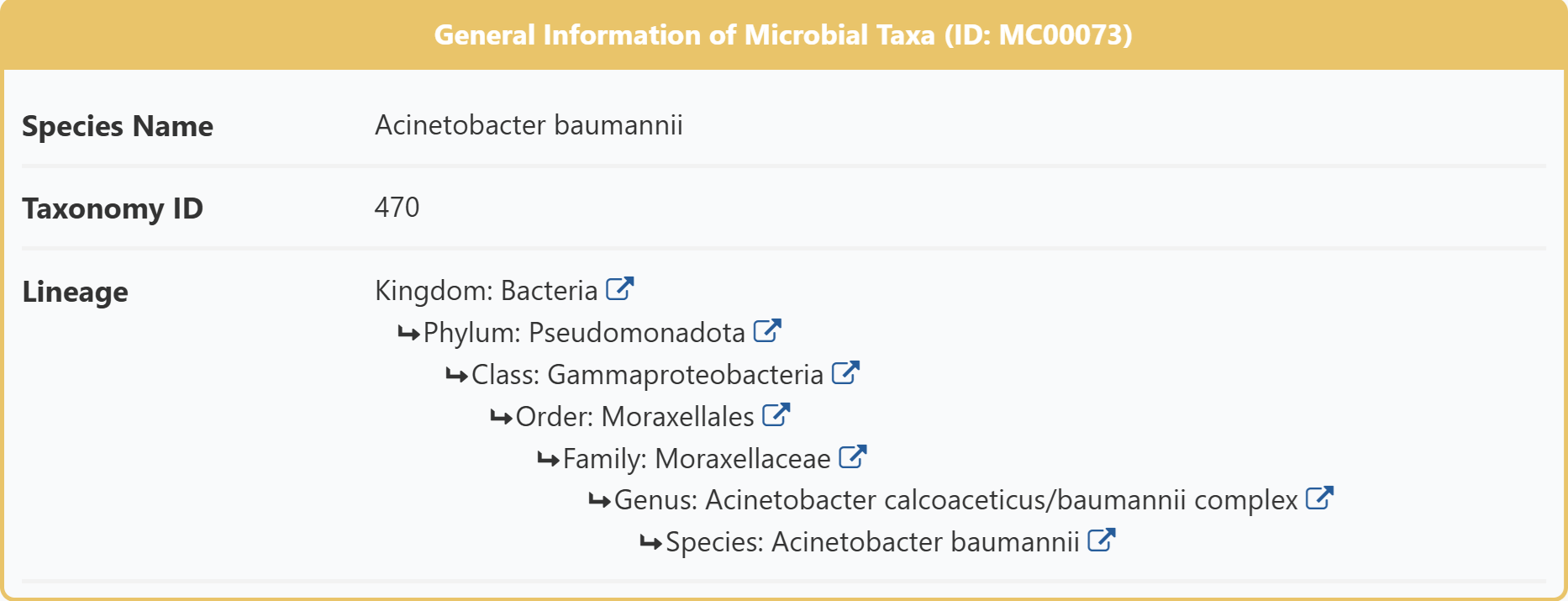
Effect of This Microbial Taxa on Drug
The interaction table named “Effect of This Microbial Taxa on Drug” lists all the drugs (including approved, clinical research, and investigational drugs) affected by this Microbial Taxa. Clicking on the drug entry in the table will expand downwards to show detailed information about the impact of this Microbial Taxa on the drug, which includes microbiota influence, related protein and detailed mechanism.
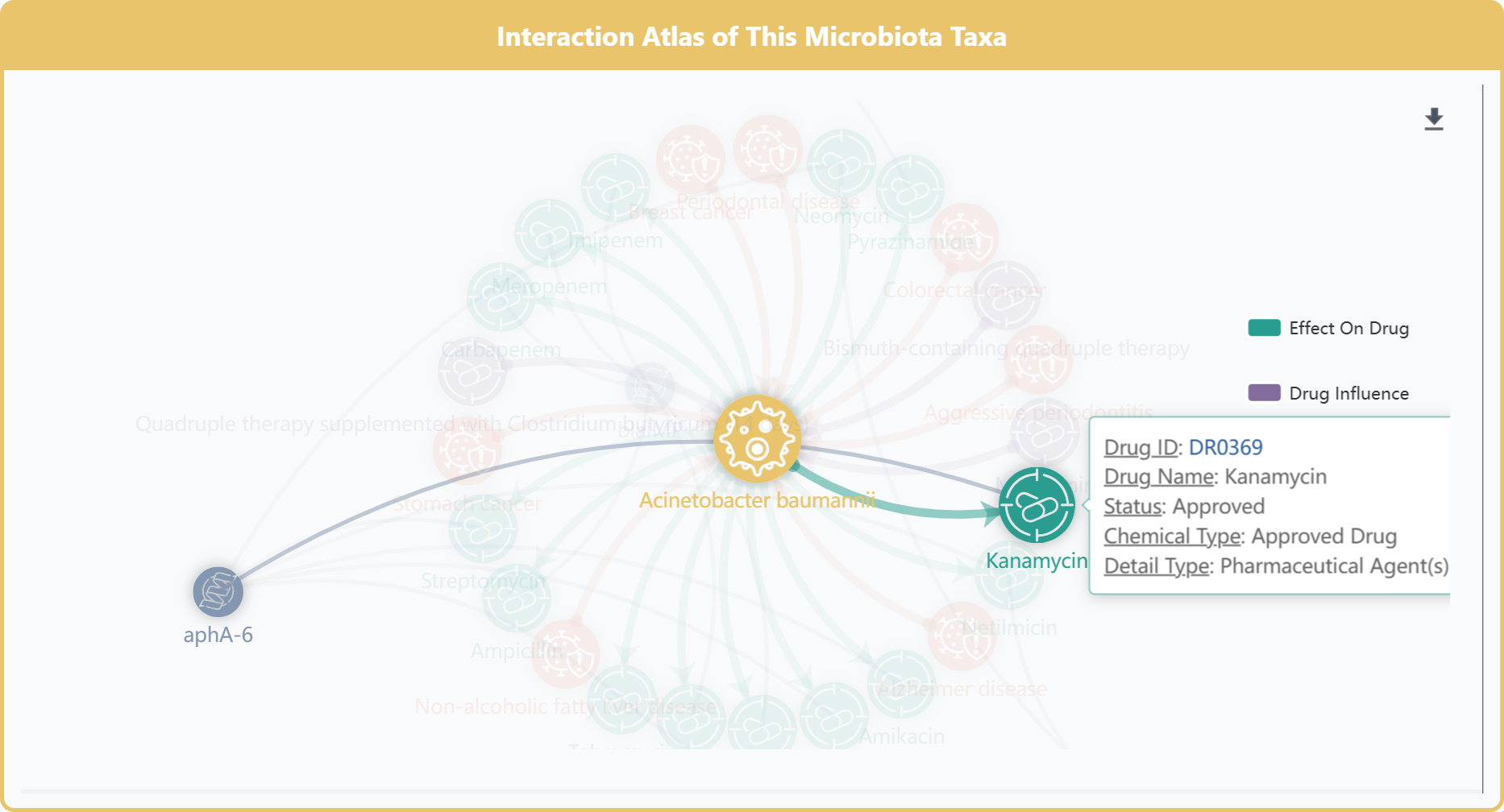
Drug (or Substance) Influence of This Microbial Taxa
In the interaction table named "Drug (or Substance) Influence of This Microbial Taxa" section, MDIPID provides information on the impact of all drugs (or substances) on the Microbial Taxa. Similarly, when users click on a drug (or substance) entry, the corresponding drug (or substance) impact information will unfold below, including drug information, experimental examples, and detailed mechanisms.
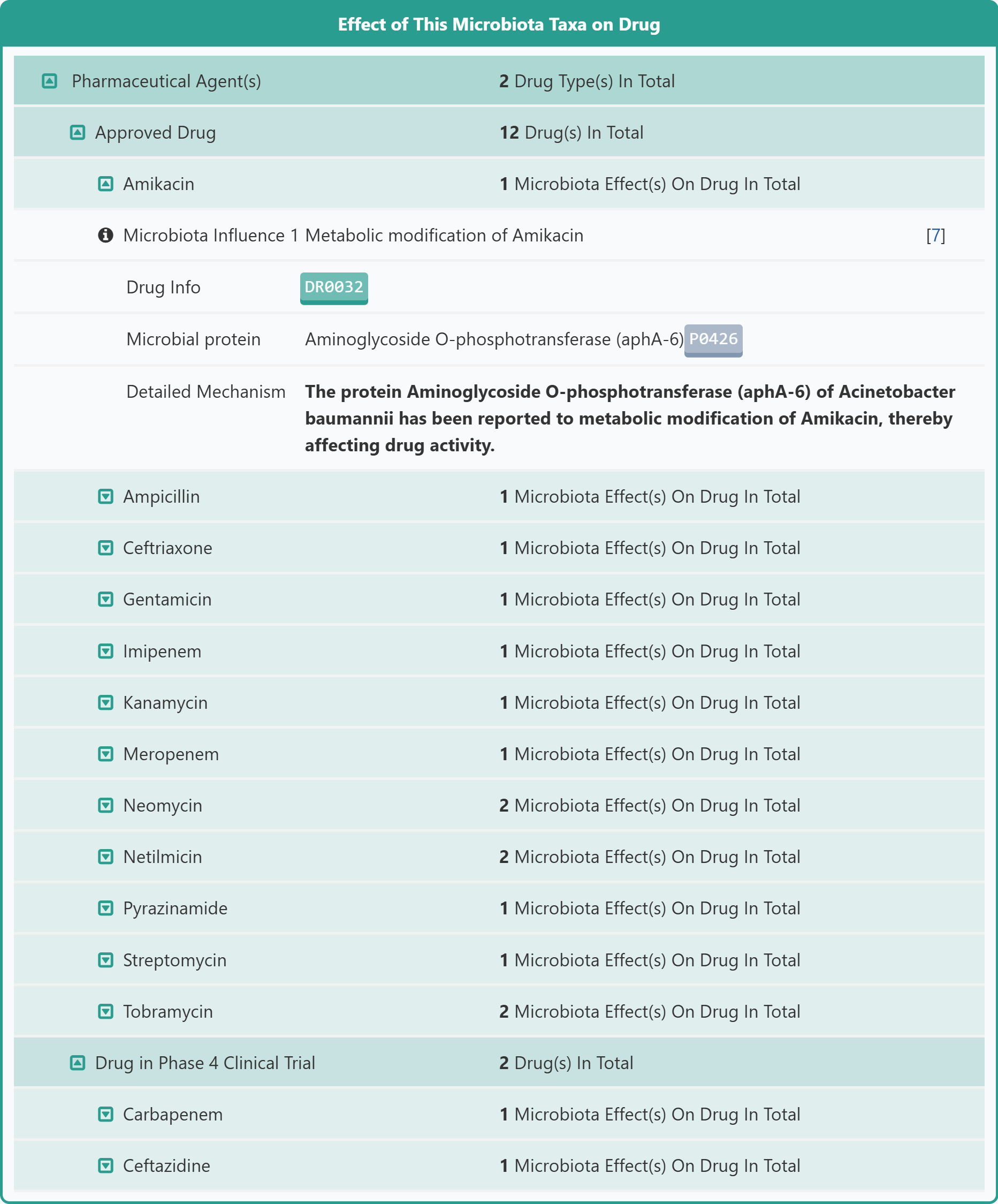
Variation in the Abundance of This Microbial Taxa Across Disease Phenotypes
In the "Variation in the Abundance of This Microbiota Across Phenotypes" section, MDIPID provides information on the variations in the abundance of this microbial taxa across different disease phenotypes. When users click on a disease entry in this table, related information such as microbiota variation, phenotype information, studied species, experimental samples, and comparative samples will unfold below.

On the search page for drugs, MDIPID offers a keyword search field for drugs and 3 drop down menu search fields, including "Search for Drug Entries by Drug Indication & Name", "Search for Substrate Drug Entries by Microbiota Genus & Species Name", and "Search for Intervention Drug Entries by Microbiota Genus & Species Name". The user can select the item they are interested in to search for drugs related to this item.

The search results page for a drug briefly displays information about Drug Name, Drug Status, Drug Class, Drug Type, and Representative Indication.

In the "General Information of Drug" section of the Drug Information page, MDIPID provides information on the Name, Synonyms, Chemical Type, Indication, Highest Status, Therapeutic Class, Drug Type, Structure, Lipinski Ro5 Violations, Chemical Identifiers (Formula, IUPAC Name, Canonical SMILES, etc.), and Cross-matching ID (PubChem CID, ChEMBL ID, CAS Number, etc.).

Interaction Atlas of This Drug/Substance
In the "Interaction Atlas of This Drug/Substance" section of the drug information page, MDIPID provides basic information about all the Microbiome(s) of pharmaceutical importance that interacting with the drug (including Substrate and Intervention) and their Related Proteins, as well as diseases treated by this drug in form of interaction map and tables.
In this interaction map, the drug is placed right in the center, and all the microbiota that the drug intervenes in, as well as those that use the drug as a substrate, and all the diseases treated by the drug, are distributed around the drug and directly connected to it (the direction of interaction is indicated by arrows). Additionally, related proteins will also be connected to the corresponding microbiota.
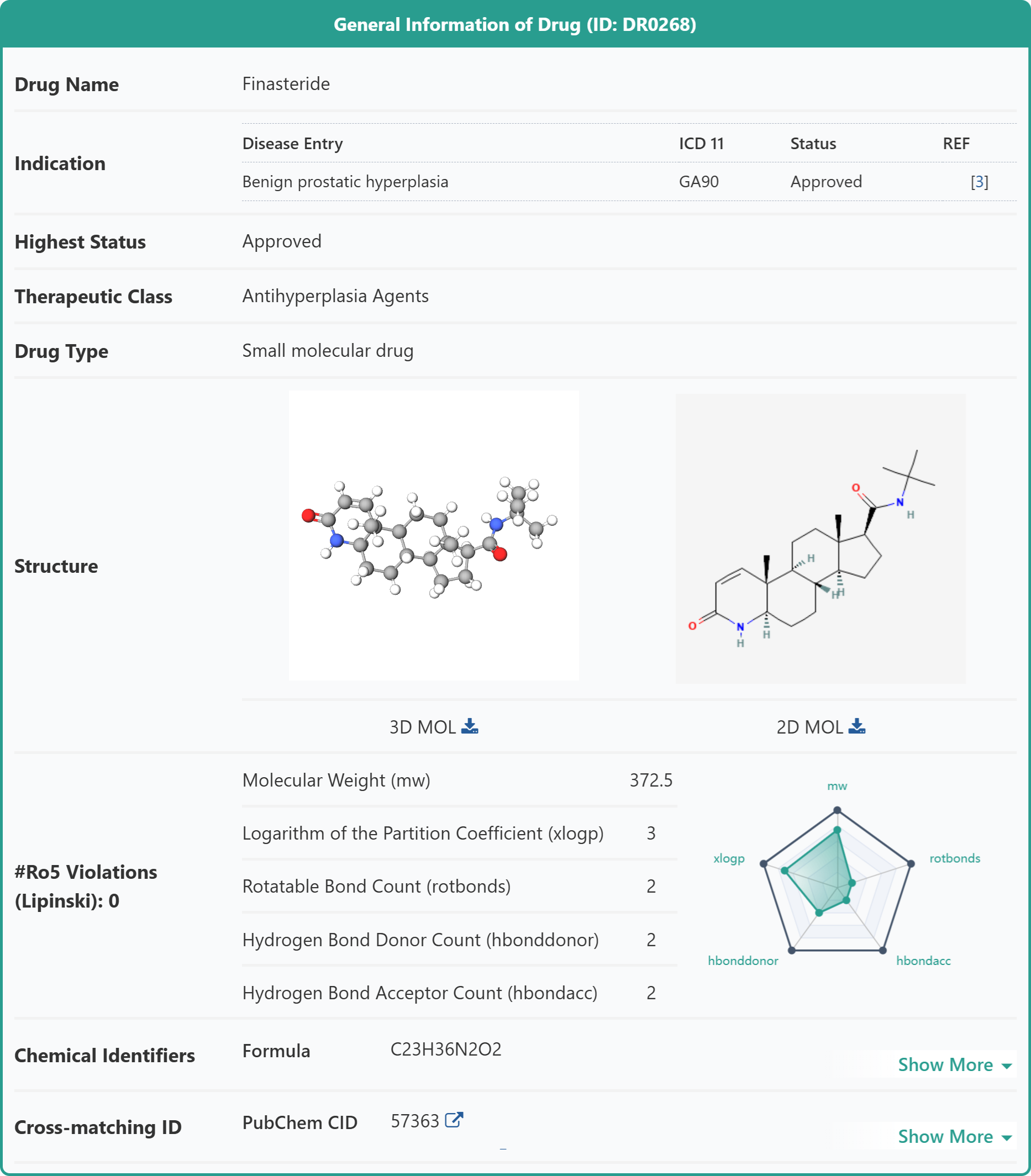
Effect of This Drug on the Microbiota
In the "Effect of This Drug on the Microbiota" section of the drug information page, MDIPID provides all the microbiota affected by the drug, and classifies them into three levels: kingdom, phylum, and species. Users can click on the microbiota entry, and detailed information about the drug's impact on that microbiota (including Drug Influence, Experiment Sample, and Detailed Mechanism) will unfold below.
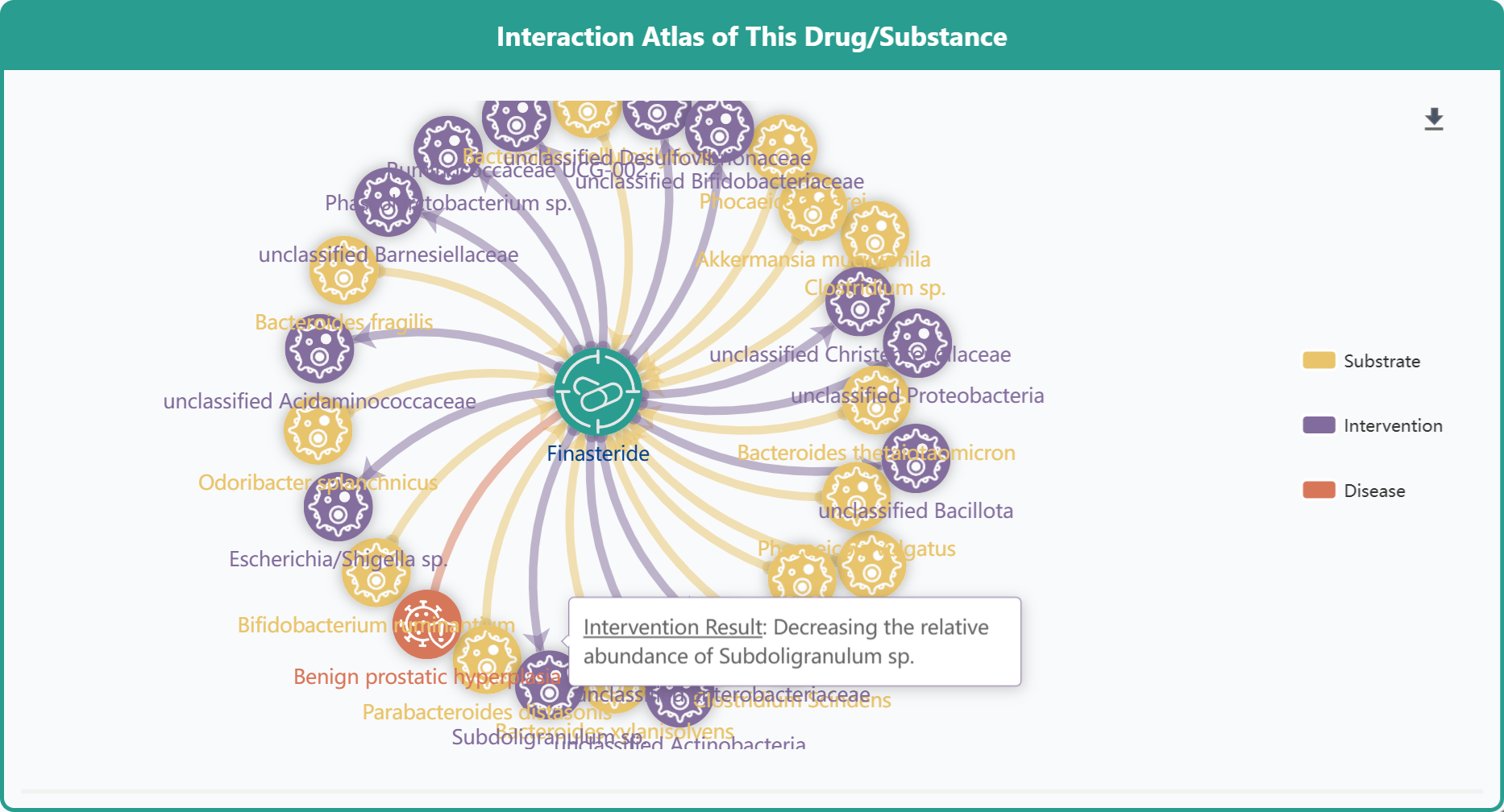
Microbiota Influence of This Drug
In the "Microbiota Influence of This Drug" section of the drug information page, MDIPID provides all the microbiota that influence the drug, and classifies them into three levels: kingdom, phylum, and species. Users can click on the microbiota entry, and detailed information about the impact of that microbiota on the drug (including Microbiota Influence, Experiment Materials, Experiment Methods, and Detailed Mechanism) will unfold below.
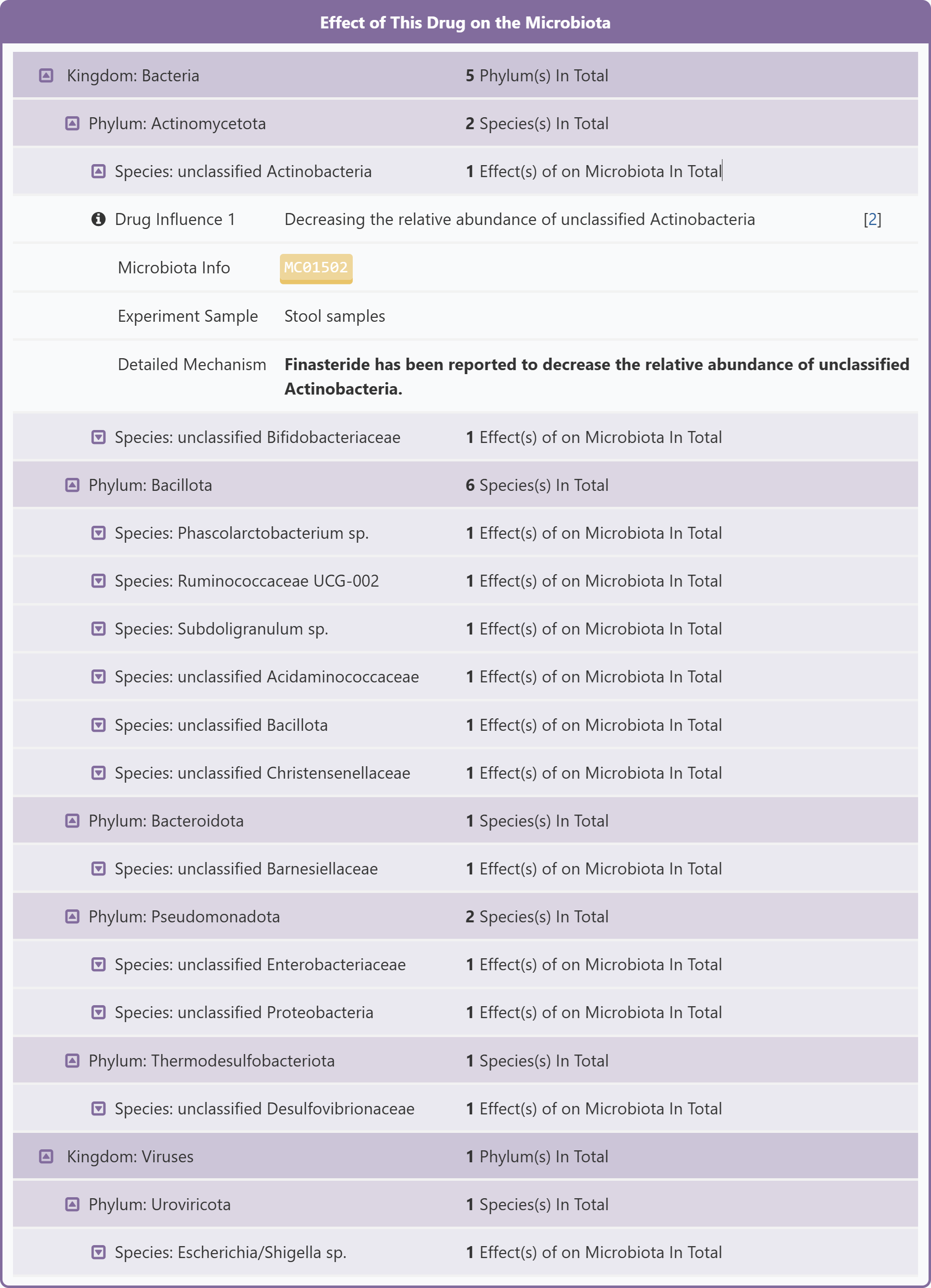
On the search page for diseases, MDIPID provides a keyword search field for Disease and 3 drop-down menu search fields that include Disease Class & Name, Microbiota Genus & Species Name, and Drug Status & Name, users can select the item of interest and search for Disease associated with that item.
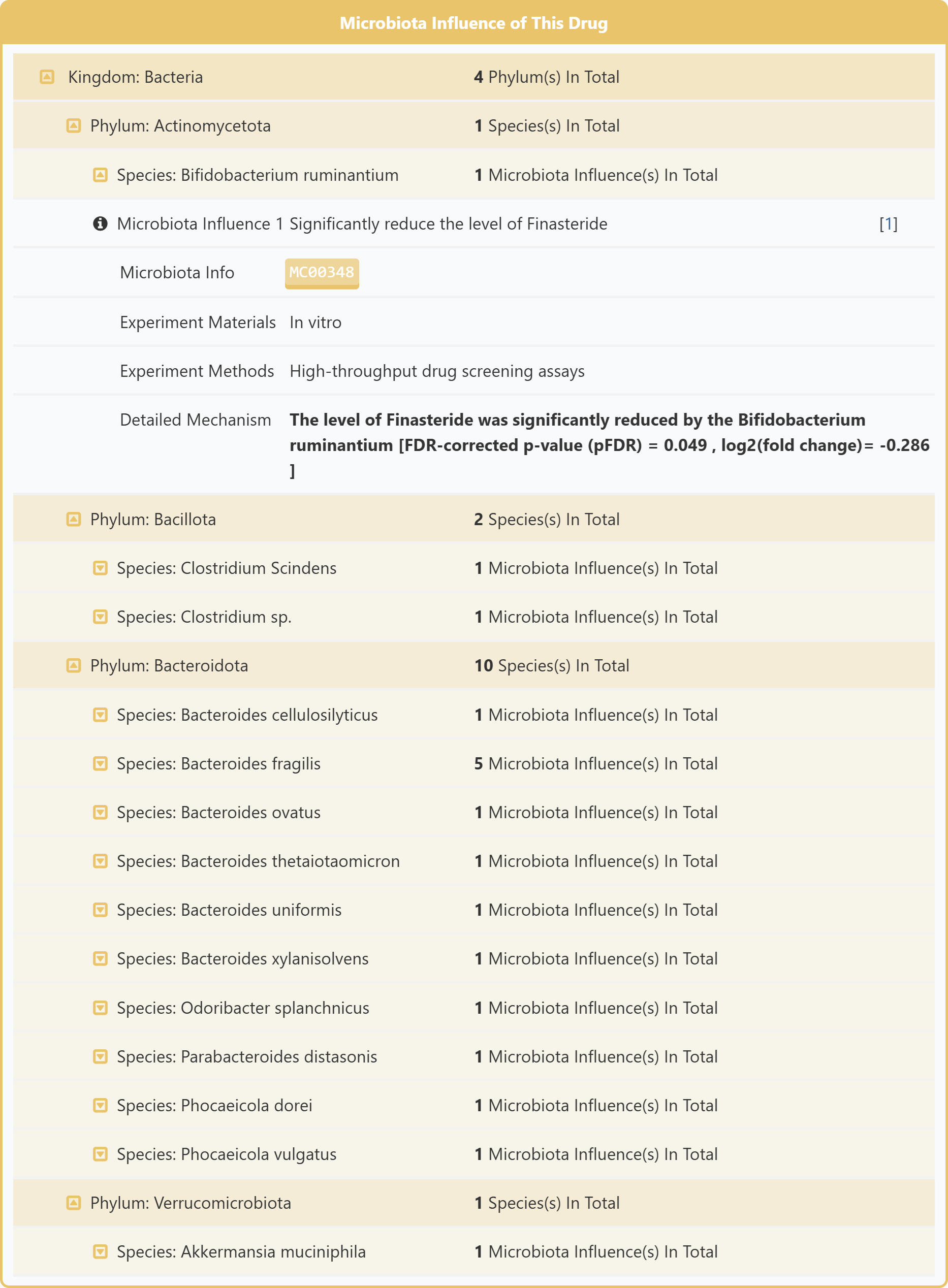
The search results page for a disease shows brief information about the disease name, disease class, ICD-11 code, representative drugs, and related microbiota.
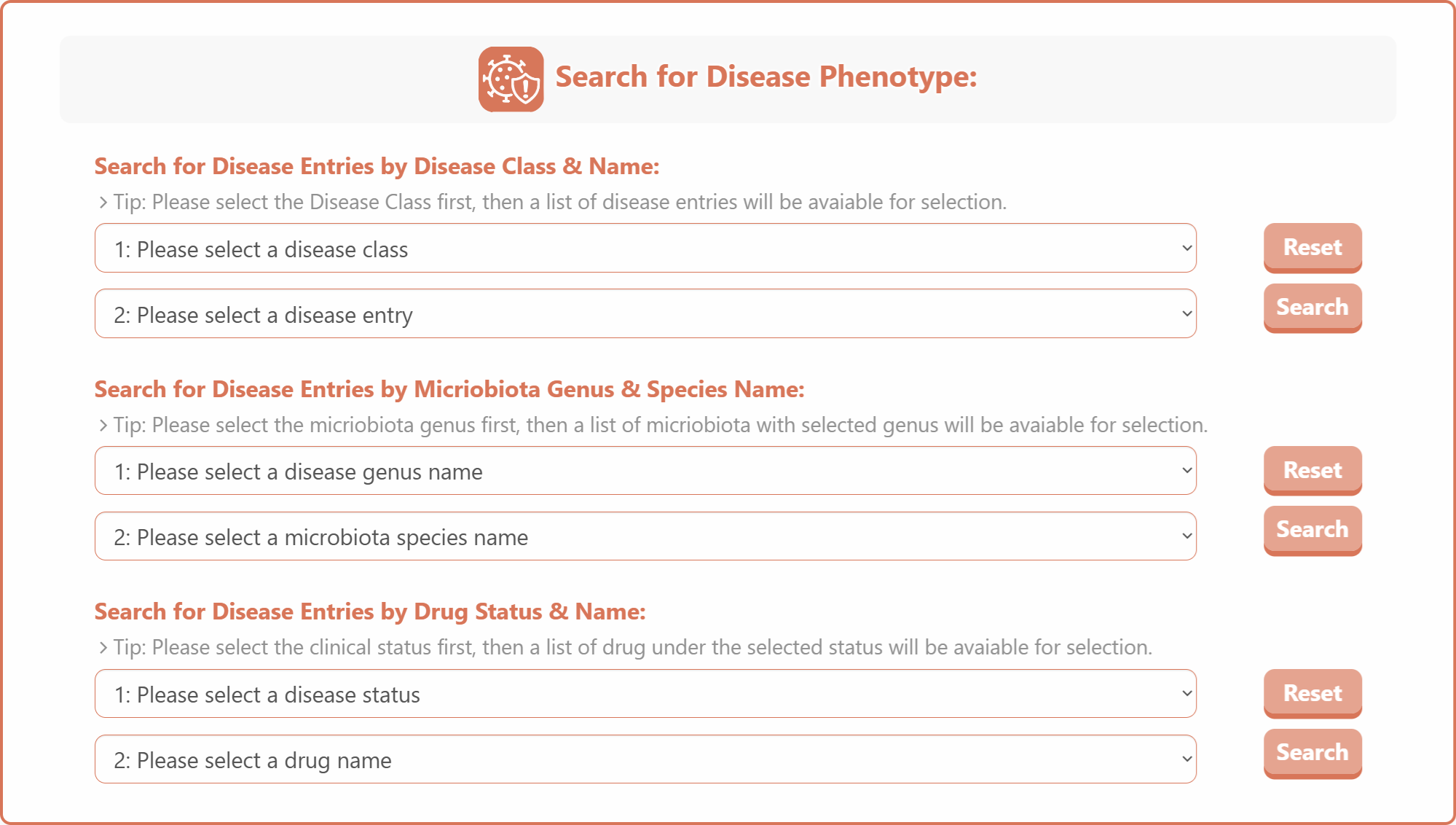
General Information of Disease Phenotype
In the "Interaction Atlas of This Disease Phenotype" section of the disease information page, a systematic organization has been carried out. All drugs in relation to this disease have been included, which covers approved drugs, drugs under clinical research, and investigational drugs. Moreover, all the microbiota associated with this disease are also incorporated, and their interactions are presented.

Interaction Atlas of This Disease
In the "Interaction Atlas of This Disease" section of the disease information page, all drugs (including approved, clinical research, and investigational drugs) for this disease and all microorganisms related to this disease have been organized.

List of Drug(s) That Treat This Disease as An Indication
In the "List of Drug(s) That Treat This Disease as An Indication" section of the disease information page, all pharmaceutical agents indicated for this disease are listed
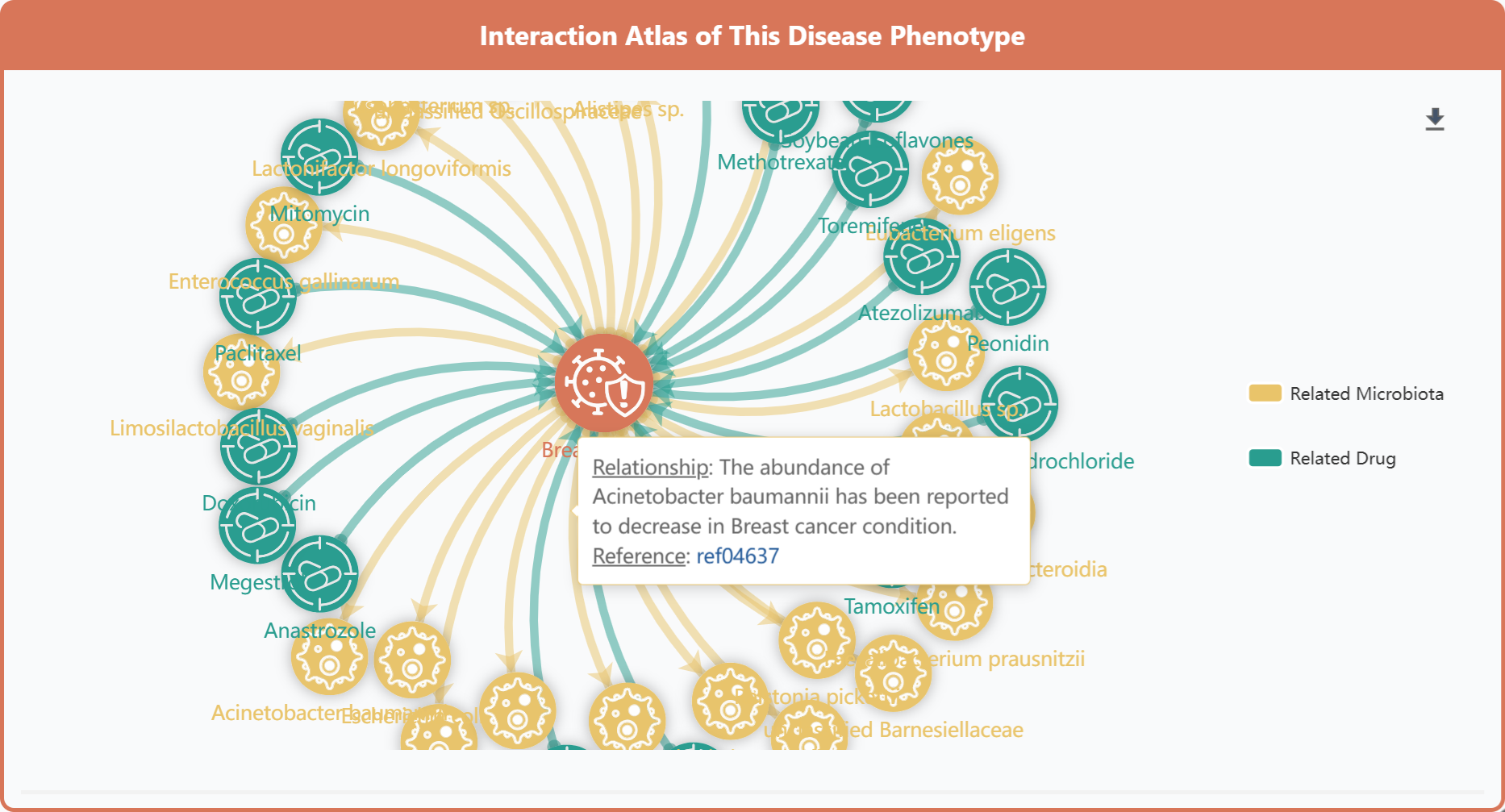
Variation in the Abundance of Microbiota Across This Disease Phenotype
In the "Variation in the Abundance of Microbiota Across This Disease Phenotype" section of the disease information page, MDIPID provides information on the variations in the abundance of microbiota across the disease phenotype. Microbiota are classifying into three levels: kingdom, phylum, and species. When users click on a microbiota entry in this table, related information such as microbiota variation, studied species, experiment sample, and compared sample will unfold below.
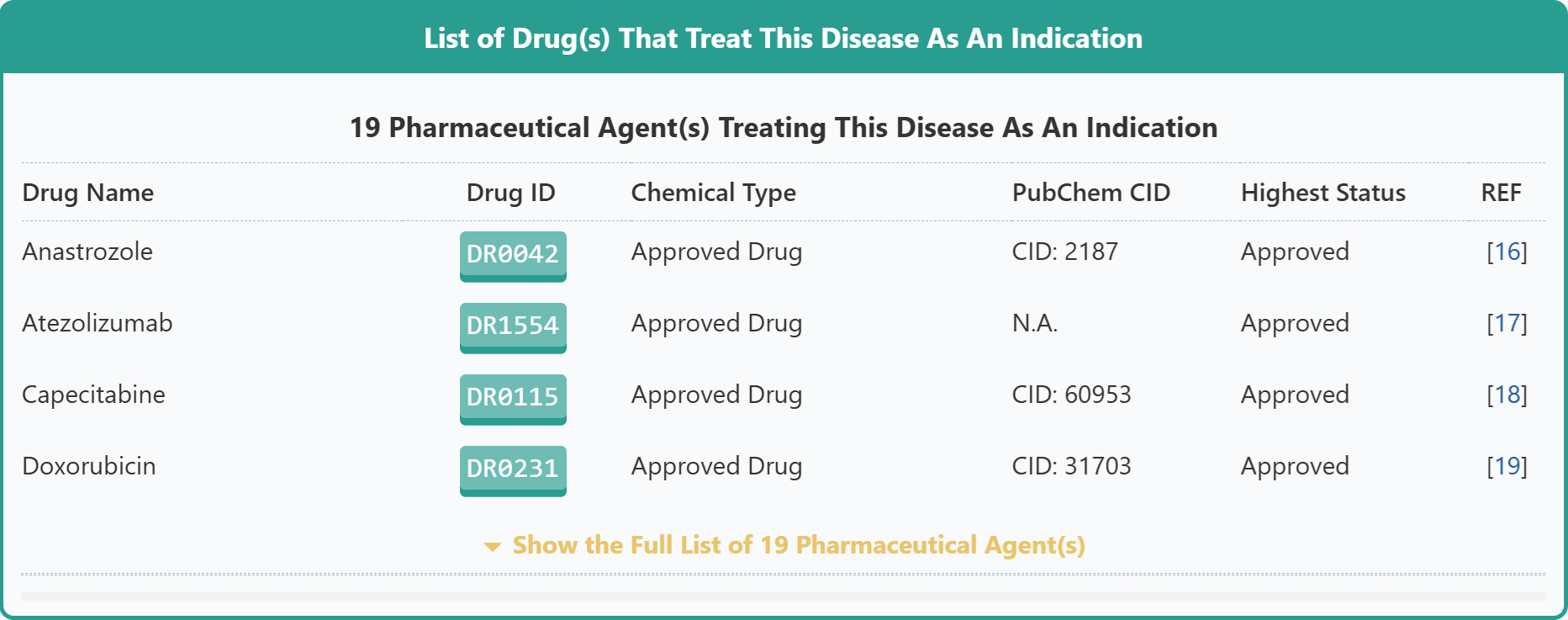
On the search page for proteins, MDIPID offers a keyword search field for proteins and 3 drop down menu search fields that include Protein Family & Name, Microbiota Genus & Species Name, and Drug Status & Name. The user can select the item they are interested in to search for Microbial Protein related to this item.
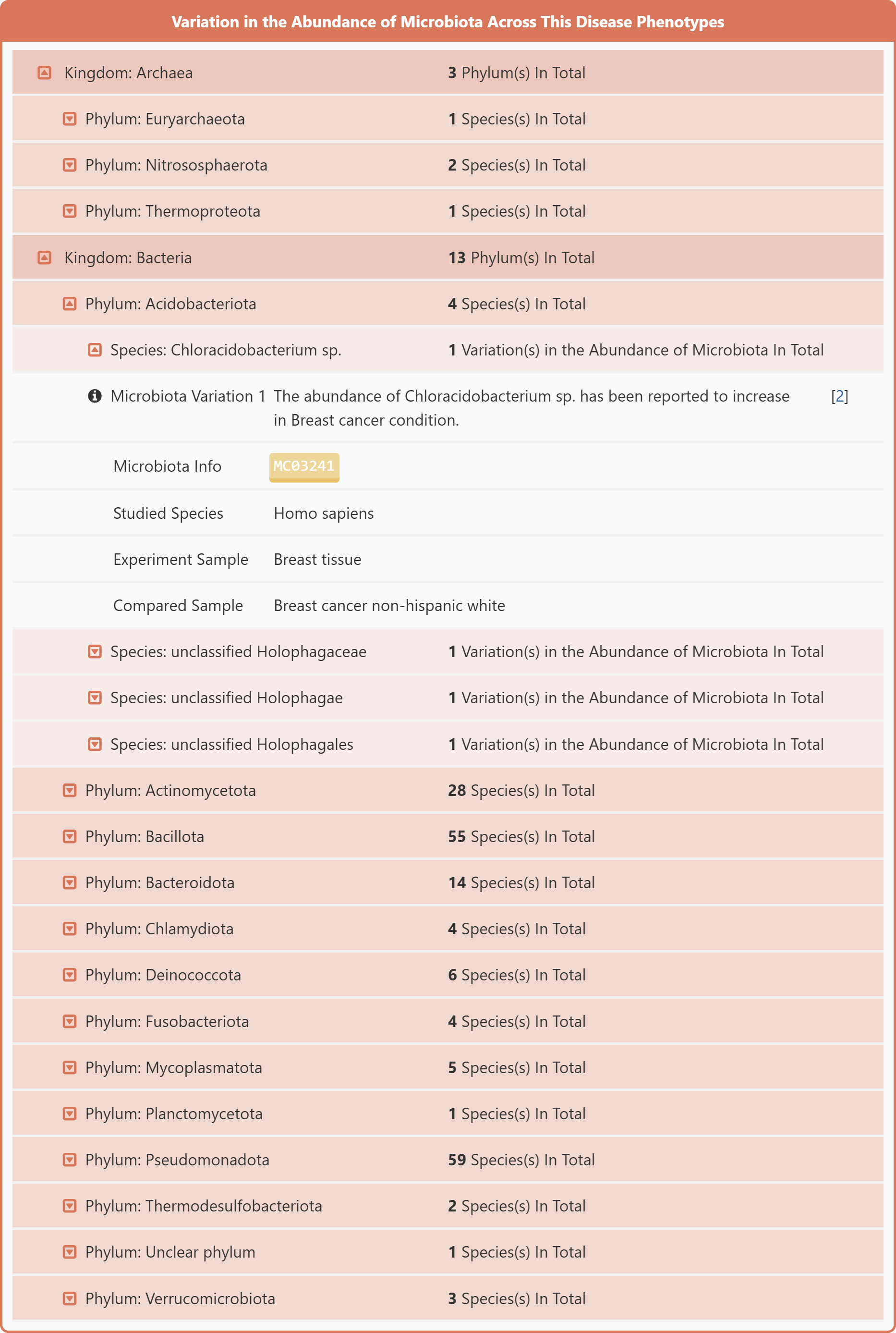
The search results page for a microbial protein briefly displays information about Protein Name, Uniprot AC, EC/TC ID, Source Microbiota and Influenced Drug.
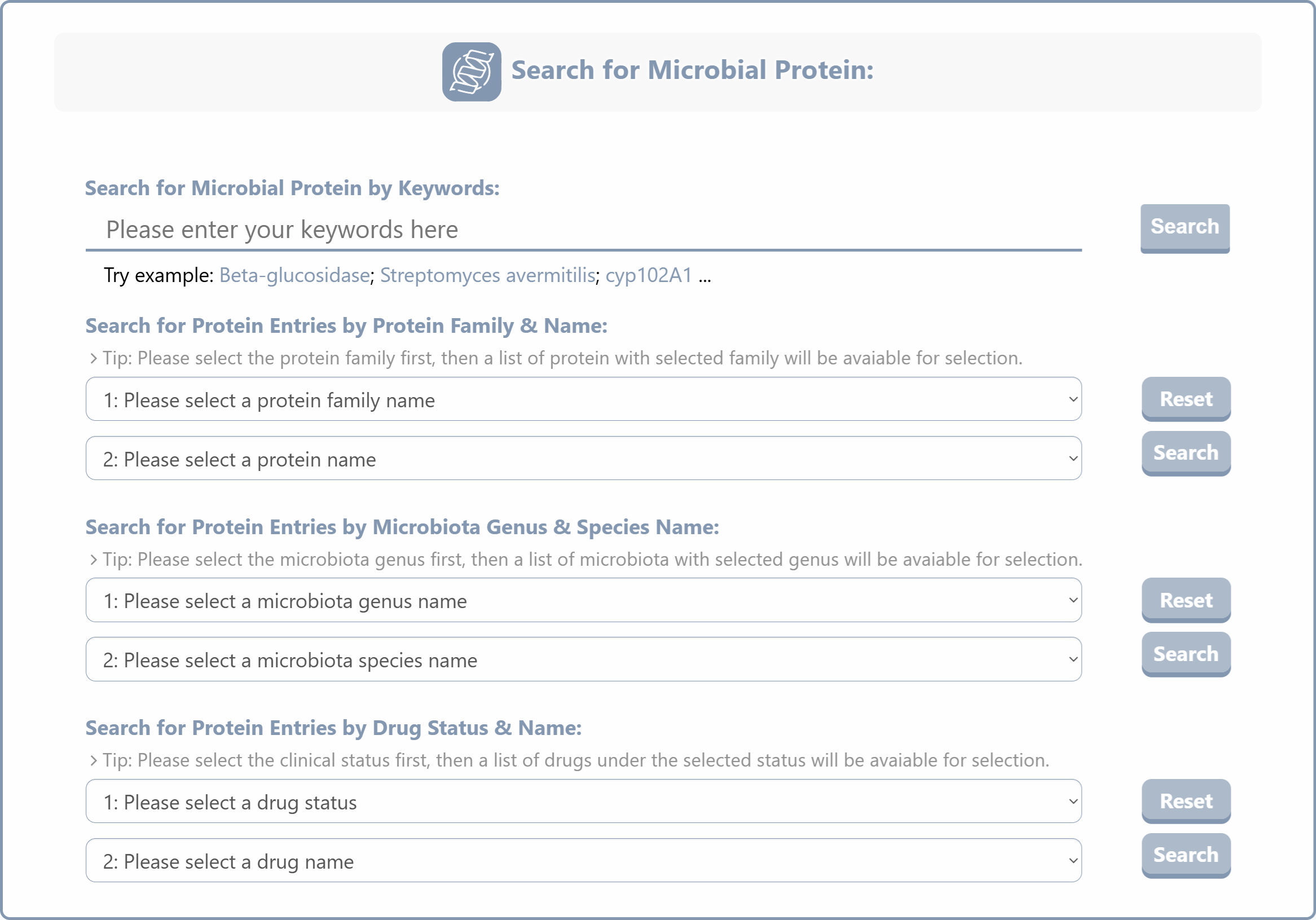
General Information of Microbial Protein
In the "General Information of Microbial Protein" section of the Protein Information page, MDIPID provides information on the Protein Name, Gene Name, Microbial sources, Functional Family, EC/TC ID, Uniprot AC, KEGG Pathway, Tissue Distribution, Function, and Sequence.

Interaction Atlas of This Microbial Protein
In the " Interaction Atlas of This Microbial Protein" section of the protein information page, all drugs involved in Microbiota-Drug Interaction affected by the microbial protein have been organized, and protein’s microbial sources displayed.
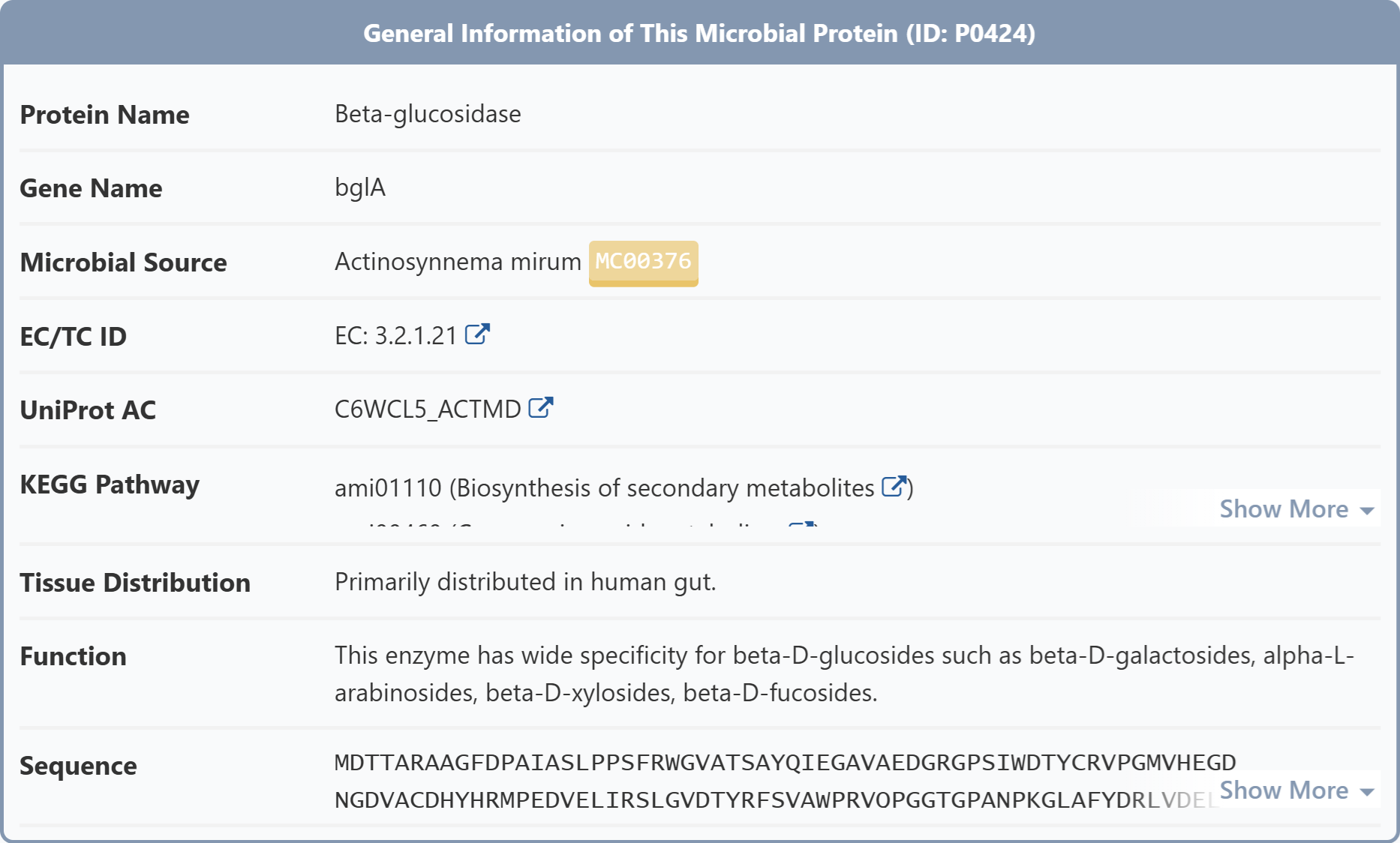
Effect of This Microbial Protein on Drugs
In the "Effect of This Microbial Protein on Drugs" section of the protein information page, MDIPID provides information on all the drugs (including approved, clinical research, and investigational drugs) affected by the Microbial Protein. When users click on a pharmaceutical agent entry in this table, related information such as protein influence, metabolic reaction, drug metabolites, affinity data, experiment materials, and detailed mechanism will unfold below.

